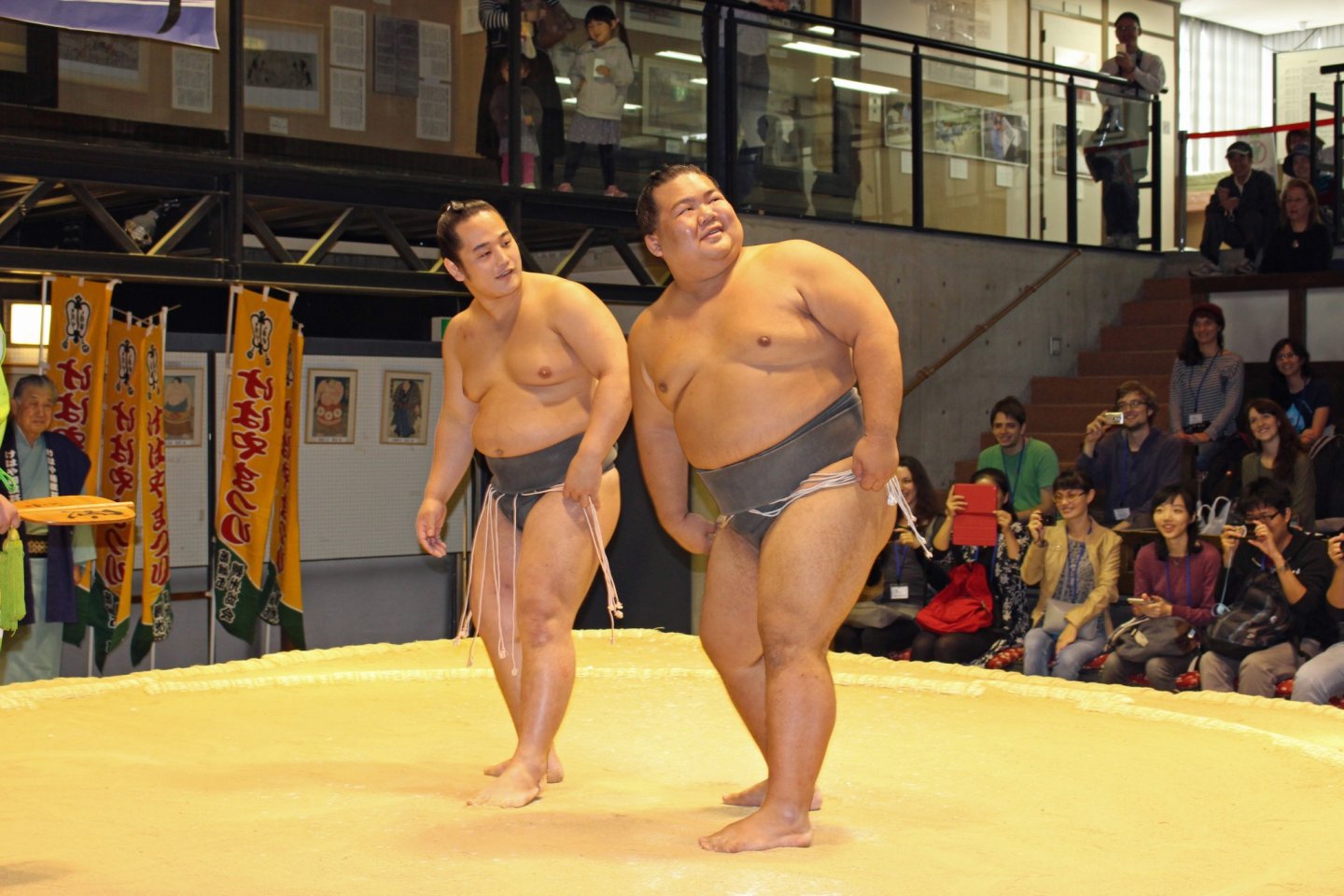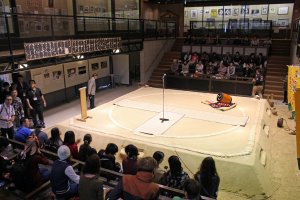“Oi! You’re too close!” One sumo wrestler (or deshi) told his larger opponent. “Step back!”
“Oh, sorry! Here?” Asked his opponent.
“No, further!” The opponent took another step back. “No, no, no! Come with me!” The smaller deshi escorted his larger opponent to the very edge of the ring and drew a line in the dirt. “Here! Don’t cross this line!” Realizing the trick, the larger deshi snuck after his opponent mimicking his every step and looking over his shoulder suspiciously. The ensuing comedic show was one of the most hilarious performances I’ve seen in Japan.
The Origin of Sumo
According to the Nihonshiki, the Chronicles of Japan, the oldest collection of Japanese historical documents, the first sumo match took place in the 7th year of the Suinin Emperor sometime between 29BC and 70AD. The story goes that in Taima Village, present day Taima-cho in Nara’s Katsuragi City, there was a man named Taimano Kehaya who possessed superhuman strength. It was said that he could break an animal’s horn with his bare hands. According to the Nihonshiki, Taimano is said to have boasted,
“There is no one in this world who can defeat me. If there is such a person, though, I want to fight him.” Word of this boast reached the court of Emperor Suinin who asked the members of his court and his servants if they knew of a man with the strength to challenge Taimano Kehaya. One servant suggested that a man named Nomino Sukune, from his home in Izumo (present day Shimane Prefecture), was the equal of Taimano. Emperor Suinin summoned Nomino Sukune to Yamato (present day Nara), and a fight was arranged. Nomino Sukune emerged as the victor of the fight with Taimano Kehaya passing away after the fight (so much for his boasting). The fight between Taimano Kehaya and Nomino Sukune is said to be the origin of sumo and it was the first such fight performed before an Emperor.
The Katsuragi City Sumo Museum
The Kehaya-za Sumo Museum, in Nara’s Katsuragi City, was established in 1990 to inform visitors about sumo and its history and tradition and pass that knowledge down to future generations. In order to accomplish this the museum has its own dohyo or sumo arena. It’s made of earth and built to same specifications as real competition dohyo. A real competition dohyo is considered a sacred space under sumo’s Shinto tradition and women and those wearing shoes are not permitted to enter the space.
The museum’s dohyo is a display piece and does not have the same restrictions. Sumo workshops, available upon request, are open to everyone and gives visitors the chance to receive sumo instruction and fight a sumo match against friends or fellow visitors. Participants in the sumo workshop also have the option of fighting the match in their own cloths with sumo attire or in a giant sumo body suit. The museum also hosts performances of Sumo Jinku, Sumo-themed songs, the first Sunday of every month, and features a gallery displaying many historical tools, articles, and literature related to sumo. Foreign visitors to the museum can receive free admission by presenting their passport at the ticket window.
This October marked the 25th anniversary of the Kehaya-za Sumo Museum’s opening and the museum celebrated with the Kehaya Matsuri (festival) over the October 10th-12th Sports Day holiday weekend. Activities like a talk show with the Mayor of Katsuragi City and Sumo style kanji calligraphy workshop, and sumo competition for Sumo’s from Nara were offered. My favorite of the events by far was the shokkiri comedic sumo show. Shokkiri means a comical display of fouls. The hair pulling, water spitting, audience teasing, slapstick show put on by two real sumo wrestlers and a gyoji, referee, recalled the antics of The Three Stooges and Bugs Bunny cartoons. It transcended language, made the tradition of sumo easily accessible to the layman and had audience members (and the performers) howling with laughter. It was a refreshing dose of humor and one of the best shows I’ve seen in Japan. This shokkiri show was a special event but others are out there. They’re worth seeking out for belly achingly good laugh.
Getting There
- The closest train station to the Kehaya-za Sumo Museum is Taimadera Station on the Kintetsu Minami-Osaka Line. It’s only served by local and semi-express trains. From Osaka get a local or semi-express train from Kintetsu Osaka-Abenobashi Station directly to Taimadera, a 37-minute train ride and ¥560 fare.
- From Kyoto get a Kintetsu Line express or limited express train to Kashihara Jingumae Station and then change to a local or semi-express train on the Minami-Osaka Line. Using the regular express and local or semi-express train costs ¥1,010 and takes about 95 minutes, using the limited express train for the run to Kashihara Jingumae incurs an additional ¥900 reserved seat fee but cuts the travel time down to 77 minutes.

































